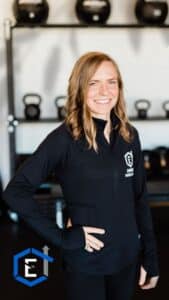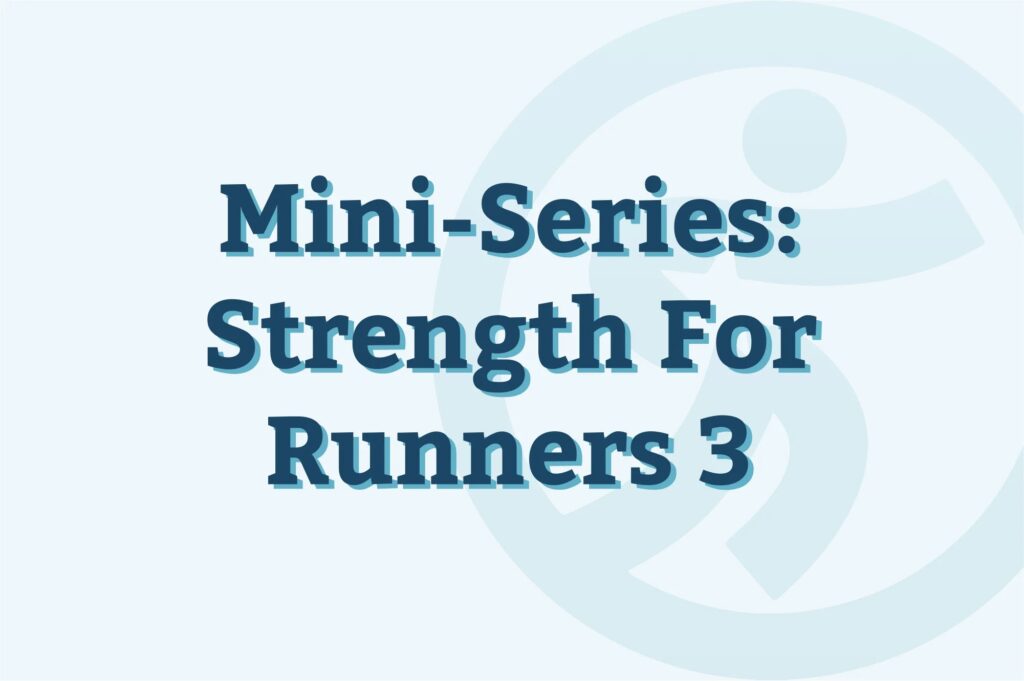How to Strength Train for Running Longevity and Performance:
In the previous post in the Mini-series of posts: Strength For Runners series, we talked about the roadblocks runners face when it comes to strength training and how we sometimes get it wrong. Today, we are going to outline the basic principles of a running-focused strength training program and what that entails!
For starters, the overall structure of a comprehensive program for runners should include mobility, stability, strength and power. For more on what each of those mean and why they’re important, see the previous post in this series!
Appropriate Movement Selection:
For runners, the following movement patterns should be high on your list of priorities:
Squat
Hinge
Upper Body Push
Upper Body Pull
Single Leg Emphasis Work
Carries
Calf Raise Varieties
Understanding Programming:
How heavy you lift (intensity), how many repetitions you do (volume), and how often you lift (frequency) play a significant role in the kind of results you’ll see in your health, performance and physique.
The table below simplifies and generalizes common rep ranges and their intended purpose:
| Weight Selection | Rep Range | Response |
| Low weight: feels like a 1-3 out of 10 when you pick it up | 15-20 reps per set | Good for basic neuromuscular adaptations within movement patterns, but doesn’t really improve muscular size or force production over the long term. |
| Moderate weight: feels like a 4-7 on a scale of 10 when you pick it up | 8-12 reps, to “failure” or to within 1-2 Reps In Reserve (RIR means feeling like you have a few more reps in the tank.) | A safe way to further improve movement proficiency while improving baseline muscular development, primarily increasing muscle size. |
| Heavy Weights (relative to the athlete): feels like a 7-9 on a scale of 10 when you pick it up. | 1-6 reps per set, 1-3 Reps in Reserve | Improves muscles’ ability to produce force via the recruitment and coordination of more muscle fibers |
Now that we’ve outlined a very basic idea of what movements to include and the intention behind different rep ranges, let’s talk about some of the principles of adaptation like specificity and progressive overload.
Strength Is Complementary:
Specificity, at its most basic level, means you need to train the thing you want to get better at. We intuitively know that sprinters train differently than marathoner trains differently than a CrossFitter. How you strength train should be dependent on your goals. If your goals are centered on running, you need to strength train like a runner!
what does that mean???
First and foremost, it means you should obviously spend more time on running than you spend on strength training. You don’t have to spend hours in the weight room.
Second, it means we should let our running training do the work of developing our aerobic fitness and let our strength training do the job it is best suited for. Runners tend to believe they need high reps/low weight (and a lot of sneaky cardio) for their strength training to be endurance-specific. They’re not necessarily wrong – high reps do target muscular endurance (see the table above). But that kind of strength training doesn’t fully equip or reinforce your body to be able to withstand the forces of running like heavier lifting can. So, when we talk about the specificity of strength training for running, we don’t necessarily need it to look like running – we need it to reinforce and train our bodies to endure the forces of running.

Also, running on its own does not strengthen your legs as well as dedicated lower body strength training does. If running covered all the leg strengthening we needed, we wouldn’t see such high rates of overuse injury in runners! Overuse injury inherently means the tissues were not strong enough for the repetitive stresses of running or they were overloaded in some capacity (i.e., too high of running intensity with too high of frequency and not enough recovery). Strength training outside of running enhances your structural durability – but only if you use enough resistance or do enough reps with a more moderate weight to stimulate your body to reinforce those vulnerable structures. Hence the need to lift heavier on occasion.
Again, your cardiovascular fitness isn’t strength training’s job. Strength is defined as the ability to produce or withstand force. Your strength training should be specific to the forces your body experiences while running, meaning it should complement your running by filling in the gaps and developing your stability, strength and power in such a way that your running can’t.
Progress Principles:
When it comes to how we think about progressing our strength, we can again draw parallels to running training. Most runners build their aerobic base and over time add progressively more challenging speed work in appropriate doses for their goals.
A quality strength training program is similar in that it should help you build a base of muscular development and movement proficiency and gradually progress into including some higher intensity work. In the world of strength training, “higher intensity” means heavier weights for lower reps.
(Good to know: Lifting heavy maximizes your muscle’s ability to produce force relative to their size, meaning it won’t make you bulky.)
In order to see progress, we need to have some consistency in our movement selection from one strength workout to the next. It’s not super effective if you’re always doing random movements for the sake of variety. We also need to utilize a strategic approach to progressions. We can’t progress if we use the same weights over and over again.
Think about it: if you are training for a particular race distance or time goal, yes, you are primarily running (so, a consistent movement selection), but you don’t go out and run the same distance at the same intensity every single time. Something about how you run, whether it’s how fast (intensity) or how far (volume), is changing over time to help you progress toward your goals. Your strength training should do the same. You might do similar movements from session to session, but something about how you are lifting should change over time.
Consistency is Key:
Again, it doesn’t have to be fancy to be effective but it should be well-rounded, comprehensive and complementary. The basics done well and done consistently are what lead to progress. The elite runners we look up to are elite, in part, because they have mastered the basics. They do the “little” things that can be so easy to ignore because they seem so … basic! But this stuff works. And it works well – provided you actually DO it and you do it with intention.
Consistent strength training is often the missing link to performance breakthroughs and long-term injury prevention, but if – like most runners – it’s something you struggle with, it can be super helpful to have a plan and some accountability. Just like your running coach, favorite local running groups, and running besties help keep you accountable to your training, it can be immensely helpful to have a running-focused strength training program developed for you by a dedicated strength coach and a community who can offer guidance and support!

As part of the team of movement experts at Empowered Physical Therapy, Coach Kaitlin Way is dedicated to helping people get and stay active doing what they love. Kaitlin believes that improving the quality of our movement, the strength and resilience of our bodies are the keys to moving better, feeling better, and running better! She has compiled her knowledge as a licensed Physical Therapist Assistant with her experience as a long-time runner and former competitive powerlifter to develop Run Empowered, a well-rounded, running-specific strength program designed to help runners “find their strong” and accomplish their goals. As a mom of two little boys, she is convinced that keeping up with her kids is the ultimate ultramarathon.
About TRWS
The Running Well Store is the premier running specialty store in Kansas City/Lee’s Summit, Missouri and Mission, Kansas! We are a locally owned business that has been in operation since 2006. You can shop in store or online. Our tagline is THE PLACE FOR EVERY PACE as we want all walkers, runners, newbies, veterans, and people who work on their feet all day to feel welcome. We know that there are a lot of options for footwear on the market and deciding what model is the right one for your needs is not easy. We are here for you! You can come into one of our three locations (Lee’s Summit, Northland, and Mission, KS) for a free stride analysis. No appointment necessary, but if you would like to schedule an appointment, click here. We take in-person and virtual fittings. Want to do research online? We have a find my fit tool that will help narrow down footwear options. We hope to hear from you soon!






